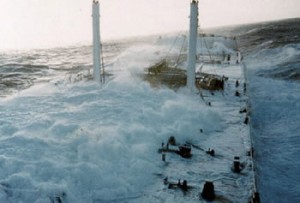Ocean Rowing – About Seaworthiness
A common misconception is that seaworthiness is related to size. A simple way to visualize the basic principles of seaworthiness is to imagine a stoppered bottle. This small buoyant object can survive immense storms, can topple end over end, be submerged by giant waves, and it will continue to float. Now imagine this same bottle with a pebble glued to the side. Back in the water, the bottle will always “right” itself with the pebble-weighted side returning to the lowest point. If we envision the bottle as a ship it is unsinkable and self-righting at only nine inches in length.
The principles of a self-righting bottle can be applied to a boat of any size. A vessel designed for offshore voyaging is made watertight by constructing watertight decks over the hull. Entrance to the interior space is via watertight hatches. Sealed like a bottle, the boat can capsize or be inverted without filling and sinking. The “pebble” takes form in the way of ballast. Ballast is any type of dense (heavy) material secured low in the ship to lower its centre of gravity to induce self-righting and stability. Ballast exerts the greatest righting force when the boat is at a ninety degree angle to normal (on its side).
Sailboats generally carry their ballast in the form of lead or iron in the keel. Powerboats are ballasted with heavy engines, fuel tanks and sometimes lead or iron. Not only is it important to place the ballast as low as possible, but also it should be positioned amidships (away from the bow or stern) to prevent hobby- horsing.
Some of the early rowboats used to cross the Atlantic were open vessels, which meant they were prone to swamping, and not fully seaworthy. Almost all modern rowboats are completely sealed, with decked-over hulls. Rowboats can use lead, steel, water or other dense materials for ballast. Fresh water is the preferred choice, since it forms the dual purpose of also being emergency drinking water. The water is stored in portable or fixed tanks secured as low as possible.
There are three factors that affect the self-righting capabilities of a vessel; ability to maintain buoyancy, centre of gravity and shape of the boat. The first two factors have been explained, but the final one is just as important. Basically, a vessel should be shaped so it is unstable in the inverted position. This will induce the boat to roll up onto its side, where the force of ballast will continue bringing it upright. A good way to visualize the attributes of proper shaping is to return to the image of the bottle. Imagine, instead of a pebble, a ping- pong ball is glued to the side. If you place the bottle in the water with the ping- pong ball facing down, it will always rotate ninety degrees because of the ping-pong ball’s buoyancy. If a pebble were glued directly across the bottle from the ping- pong ball there are now two self-righting forces – centre of gravity and centre of buoyancy.
Raising centre of buoyancy could be achieved by sticking a big beach ball at the top of a mast, however this is not practical. Instead, a well-designed boat creates buoyancy aloft through the shape of the hull, decks and cabin.
A properly shaped, ballasted, and sealed boat cannot sink or remain inverted unless its waterproof integrity is compromised or the ballast shifts.
Bulbous cabins on ocean rowboats help raise the centre of buoyancy. A common reason for ocean rowboats failing to self-right is due to not closing the entrance hatch. Upon inversion the cabin immediately fills with water and former buoyancy is transformed to two tons of salt-water ballast. The boat is now stable in the inverted position.

